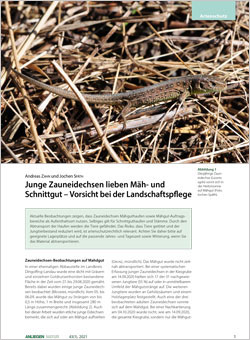Junge Zauneidechsen lieben Mäh- und Schnittgut – Vorsicht bei der Landschaftspflege

Diesjährige Zauneidechse (Lacerta agilis) sonnt sich in der Herbstsonne auf Mähgut (Foto: Jochen Späth).
Andreas Zahn und Jochen Späth
Junge Zauneidechsen lieben Mäh- und Schnittgut – Vorsicht bei der Landschaftspflege
Aktuelle Beobachtungen zeigen, dass Zauneidechsen Mähguthaufen sowie Mähgut-Auftragsbereiche als Aufenthaltsort nutzen. Selbiges gilt für Schnittguthaufen und Stämme. Durch den Abtransport der Haufen werden die Tiere gefährdet. Das Risiko, dass Tiere getötet und der Jungtierbestand reduziert wird, ist artenschutzrechtlich relevant. Achten Sie daher bitte auf geeignete Lagerplätze und auf die passende Jahres- und Tageszeit sowie Witterung, wenn Sie das Material abtransportieren.
Summary
Young sand lizards love heaps of grass – be careful when mowing for habitat management
Recent observations show that jung sand lizards (Lacerta agilis) use mown grass for basking and as refuge. They have frequently been detected in heaps of grass but also within areas with hay transfer to restore species rich grasslands. We already know that lizards also useheaps of branches or stacks of wood. When in the course oft landscape-management heaps of grassy or woody material are removed, there is risk, that lizards dwelling in or on them are killed or injured which is prohibited by species protection law. Thus, to minimize deterior effects on lizard populations, the location of heaps or piles should be carefully selected (for example at shaded sites). The time of heap and stack removal is also decisive. Weather, daytime and season should facilitat a high activity of sand lizards to let them escape.
Zum Volltext-Download:
ANLiegen Natur 43/1 (2021): 4 Seiten als Volltext herunterladen (pdf barrierefrei 0,9 MB).
 | 0
| 0 
